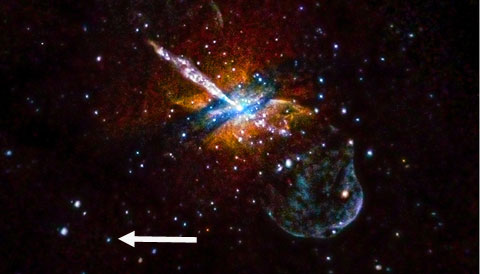Two sources tens of millions of light-years away have sent puzzling X-ray flares blazing our way. Now astronomers think they might have the answer: intermediate-mass black holes.

NASA / CXC / UA / J.Irwin et al.
During every second of daylight, more than a trillion photons flood through the pupil of your eye. Yet it took only a dozen or so X-rays to reveal brilliant flashes coming from an unknown source tens of millions of light-years away.
X-rays are hard to come by. They’re only produced in the most energetic and violent processes, such as you might find in the magnetic field around a neutron star or in a black hole’s relativistic jet. So when a source emitted a whopping six X-ray photons in 22 seconds, compared to its usual rate of six photons per hour, astronomers took notice. Six photons may not sound like a lot, but if they’re coming from millions of light-years away, they point to a whole bunch of energy, of which we’re only seeing a small fraction.
When the same team found another source with similar behavior, but recurring every few years, they began narrowing down the possible explanations. Soon they had eliminated all but one: intermediate-mass black holes, the long-looked-for “inbetweener” beasts too large to have been formed by a single star’s death but much smaller than the supermassive black holes in galaxies’ centers. The results and reasoning are published in the October 20th Nature (full text here).
“Suitably Straightforward”
When three undergraduate students began working with Jimmy Irwin at the University of Alabama’s astronomy department, they only had a few hours a week to devote to research. So Irwin set them to work on a simple project: trawl through the Chandra X-ray Observatory archive and look for things that “twinkle.” What they were looking for were black holes with stellar companions — these sources are common and frequently double or triple in brightness over an hour or so before fading away again.
“A handful of such objects had been found previously,” Irwin says, “Searching through the Chandra archive for more examples seemed like a suitably straightforward project for undergraduates.”
Instead, the students happened upon something completely different: two spectacular sources that brightened by a factor of 100 or 200 over less than a minute. After the first source’s flare, they spotted a second source near Centaurs A that went from ten photons every three hours to 10 photons in a 51-second timespan. Both sources slowly faded over an hour before they returned to pre-flash levels.
“We were quite surprised,” Irwin says. “We’ve never seen anything like this.”

NASA / CXC / UA / J.Irwin et al.
And that wasn’t all — going back through the Chandra archives showed that the second source actually had erupted four previous times, twice in 2007 and once each in 2009 and 2014. That immediately pointed to some “non-cataclysmic event”: whatever was generating these brilliant flashes wasn’t destroying itself.
Whatever is behind the brilliant, repeat flashes, it’s not common: Irwin’s students analyzed the X-rays from 70 nearby galaxies, as well as the Milky Way, and found no other flares.
Previous observations had already zeroed in on where the flashes hail from: the first source is probably a globular cluster, an old ball of stars neighboring the elliptical galaxy NGC 4636; the second source, possibly a dwarf galaxy, lives near the active galaxy Centaurus A.
Intermediate Monster Black Holes
What boosts its brightness by at least 100 times in mere seconds, fades over an hour, and lives among old stars such as found in globular clusters and dwarf galaxies?
At first, the team was inclined to look at neutron stars. After all, these crushed stellar remnants host powerful magnetic fields and can flash and flare in myriad ways depending on their age and environment. But even the most powerfully magnetized neutron stars simply don’t have the power to generate the energy inherent in these brief flares.
Which leaves one remaining option: “All of these observations seem to suggest the presence of a black hole,” says Sergio Campana (Astronomical Observatory of Brera, Italy), who wrote a perspective piece to accompany the study in Nature.
Intermediate mass black holes between 100 and 1,000 times the mass of the Sun — those not quite small enough to come from a collapsed star and not quite big enough to sink to its galaxy’s center — provide an easy explanation for some bright X-ray sources. But even if black holes provide enough energy to power these flares, it’s still unclear why they would be flaring.
Irwin and colleagues have already applied for X-ray and visible-light followup observations of the two sources, both to better determine their origins and perhaps to catch another flare in action. The discovery also points to the legacy value of Chandra’s data archive — if a first search found these two, could a wider search of, say, the XMM-Newton archive find more?
“Now that we know these strange objects are out there,” Campana says, “they will remain on the watch list.”
 2
2









Comments
dk
October 20, 2016 at 4:08 pm
Hello Monica! Do you know whether this strange phenomenon is seen in the direction of Constellation Orion? It would be greatly helpful if you can find this for me. Thank you!
You must be logged in to post a comment.
Monica YoungPost Author
October 20, 2016 at 4:25 pm
Sorry, neither are in Orion. The source near Centaurus A is in the constellation in Centaurus and the source near NGC 4636 is in Virgo. In any case, these won't be observable by eye.
You must be logged in to post a comment.
You must be logged in to post a comment.